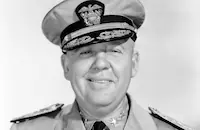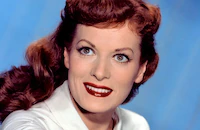Jamaica Inn

Brief Synopsis
Cast & Crew
Alfred Hitchcock
Charles Laughton
Horace Hodges
Hay Petrie
Frederick Piper
Herbert Lomas
Film Details
Technical Specs

Synopsis
As the wind whips the Cornish Coast, a band of cutthroats scuttle ships unlucky enough to sail past the Jamaica Inn. Into this air of foreboding comes Mary, looking for her aunt Patience, the sister of her dead mother. Stranded on the road to the inn, Mary meets Sir Humphrey Pengallan, a half-mad squire who is so taken with her beauty that he offers to accompany her to the inn. Once there, Mary is greeted by a leering bully of a man, who turns out to be her uncle, Merlyn Joss. Joss is the leader of the pirates, but secretly, Sir Humphrey is the real brains of the operation, and he orders Joss to allow Mary to stay. That night, Mary watches in horror as the pirates prepare to hang Jem Trehearne, whom they suspect of pilfering their booty. As the men fight over Trehearne's shoe buckles, Mary cuts the rope, and the two fugitives flee into the night. Unwittingly, they turn to the squire for help. Trehearne confides that he is an undercover police officer investigating the wrecks off the coast. The squire tricks Trehearne into returning to the inn with him, and Mary, overhearing the confession, rides to warn her aunt. While the squire and Trehearne await the arrival of the mastermind, the scuttlers appear and take them prisoner. After the men leave to scuttle another ship, Trehearne is shocked as Sir Humphrey unties his own bonds and orders Patience to stand guard over Trehearne. After the squire departs, Trehearne strikes a bargain with Patience: his freedom for that of her husband. Trehearne then rides for help as Mary attempts to warn the unsuspecting ship. Enraged, the men shoot Joss as he tries to protect Mary from their wrath. She then manages to return to the inn, where she is kidnapped by the crazed squire, who carries her off to his ship. Returning with the troops in the nick of time, Trehearne captures the scuttlers and rescues Mary as the squire leaps to his death.

Director

Alfred Hitchcock
Cast

Charles Laughton
Horace Hodges
Hay Petrie
Frederick Piper
Herbert Lomas
Clare Greet
William Devlin
Jeanne De Casalis
A.bromley Davenport
Mabel Terry Lewis
George Curzon

Basil Radford

Leslie Banks
Marie Ney

Maureen O'hara
Emlyn Williams
Wylie Watson
Morland Graham
Edwin Greenwood
Stephen Haggard

Robert Newton

Mervyn Johns
Crew
Eric Fenby
Sidney Gilliat
Sidney Gilliat
Robert Hamer
Joan Harrison
Bernard Knowles
Charles Laughton
Frederick Lewis
Molly Mcarthur
Hugh Perceval
Erich Pommer
Erich Pommer
J. B. Priestley
Alma Reville
Jack Rogerson
Harry Stradling
Harry Watt
Ern Westmore

Videos
Movie Clip






Film Details
Technical Specs

Articles
Jamaica Inn
Jamaica Inn (1939) was the first of three Daphne Du Maurier adaptations that Alfred Hitchcock directed, which would seem to indicate something of the esteem in which he held the novelist. (The other two films were, of course, Rebecca (1940) and The Birds, 1963.) But in fact it was lead actor Charles Laughton who initially suggested that Hitchcock direct the project. Laughton had just established a production company named Mayflower Films with the famed German producer Erich Pommer, who had relocated to England after the rise of the Nazis. From the very start Jamaica Inn was conceived as a starring vehicle for Laughton, and the presence of a competing creative force in the film perhaps contributed to Hitchcock's general unease about directing it. During this time Hitchcock also read the galleys for the soon-to-be-published Rebecca, which he decided at once to adapt as his first feature in Hollywood.
Daphne Du Maurier's original novel of Jamaica Inn contains many elements from gothic literature, including a bleak, windswept landscape, a mysterious inn, and violent passions, anticipating the author's full embrace of the genre in Rebecca. Hitchcock and his screenwriters made some significant changes to the original story: in the book Mary's love interest Jem was Joss Merlyn's younger brother (!) and the villain was a mad vicar named Davey. Naturally, Laughton had that juicy part in mind for himself. However, since they wanted to achieve the widest possible distribution in the US, they decided to consult with the Production Code Administration during the script development stage. Not surprisingly, the American censors balked at the idea of a clergyman being the villain, so the scriptwriters invented the character of Sir Humphrey Pengallan instead. The script team included: Sidney Gilliat, who had worked with Hitchcock on The Lady Vanishes (1938); Joan Harrison, who was one of Hitchcock¿s most trusted assistants--and whom he would bring with him to America; and J. B. Priestley, the respected British playwright and novelist who, among other things, wrote the book Benighted, which James Whale adapted into the campy 1932 horror film The Old Dark House.
The film was Maureen O'Hara's first leading role, though by that time she was already established as a stage actress in Dublin. In her autobiography, entitled 'Tis Herself, O'Hara recalls that she had just completed a screen test that she regarded as a disaster, when she signed up with a major talent agency in London and the agency¿s co-owner, Vere Barker, introduced her to Charles Laughton. The actor invited her to do a cold reading of a script, which she refused to do out of principle. Laughton and Pommer nonetheless obtained her screen tests afterwards. Impressed with how well her eyes photographed, they cast her in a B-musical entitled My Irish Molly (1938). O'Hara's next project was Jamaica Inn, for which she was assigned the leading role opposite Laughton; she again starred opposite Laughton in their next feature, The Hunchback of Notre Dame (1939).
During its original release, Jamaica Inn was usually regarded as more of a Laughton vehicle than a Hitchcock film per se. The critic for Time wrote, "Charles Laughton's impersonation of a Nero-like Cornish squire....was magnificent in the eye-rolling, head-cocking, lip-pursing, massively mincing Laughton style." Frank S. Nugent of the New York Times also praised Maureen O'Hara's "charming naturalness and poise." Indeed, this was the film that established Maureen O'Hara as a star. Incidentally, the film's score was by Eric Fenby, who got his start as an assistant to the composer Frederick Delius; Fenby's memoirs of his years with the irascible Delius were adapted by Ken Russell into the remarkable television film Song of Summer (1968).
Producer: Erich Pommer
Director: Alfred Hitchcock
Screenplay: Sidney Gilliat and Joan Harrison, with additional dialogue by J. B. Priestley; based on the novel by Daphne Du Maurier
Photography: Harry Stradling and Bernard Knowles
Editing: Robert Hamer
Settings: Tom Morahan
Costumes: Molly McArthur
Music: Eric Fenby
Cast: Maureen O'Hara (Mary), Charles Laughton (Sir Humphrey Pengallan), Leslie Banks (Joss Merlyn), Marie Ney (Patience), Robert Newton (Jem Trehearne), Emlyn Williams (Harry the Peddler), Wylie Watson (Salvation Watkins), Morland Graham (Sea Lawyer Sydney), Edwin Greenwood (Dandy), Mervyn Johns (Thomas), Stephen Haggard (the Boy), Horace Hodges (Butler), Hay Petrie (Groom), Frederick Piper (Pengallan's agent).
BW-99m.
by James Steffen

Jamaica Inn
Quotes
Trivia
Notes
This film was distributed in Great Britain by Associated British Picture Corp. Although the opening credits say "introducing Maureen O'Hara," this was not her first film. It was, however, one of her first roles as a featured player and her first release to the American market. A news item in New York Times adds that O'Hara was discovered by producer Erich Pommer. This picture marked director Alfred Hitchcock's last British film before leaving for the United States to direct Rebecca (see below), which was also based on a Daphne Du Maurier novel. A news item in Hollywood Reporter notes that Mayflower Films began production on the picture in April 1937, but shelved it in May 1937 to begin the film White Gold. An item in New York Times notes that the lead character was originally a parson but was changed to a squire to avoid anticipated objections from religious groups to his licentious behavior. Materials contained in the BFI Library note that playwright Clemence Dane worked on a first draft of the script, and that Charles Laughton brought in J. P. Priestley to build up his part with additional dialogue. Du Maurier's novel was filmed for television in 1985, as a British-American co-production starring Jane Seymour and Patrick McGoohan.














